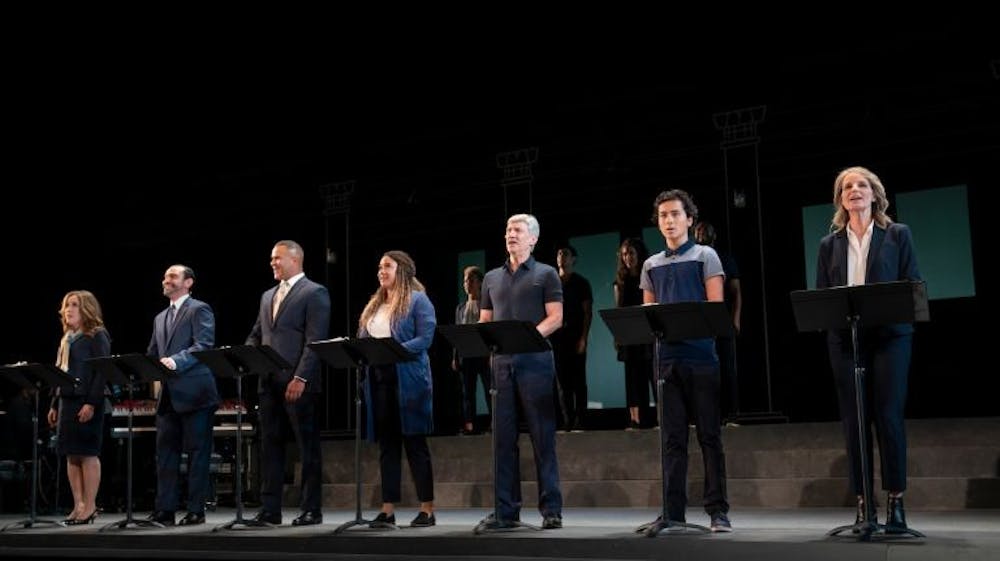The phrase “working-class” often conjures up antiquated and monotonously serene urban pastoral images—a factory worker stands by an assembly line with a shy smile and a gray uniform, building a Ford Model T as though time loops. Working: A Musical aims to dispel that notion, exposing the three–dimensional narratives of those that serve our food, park our cars, and teach our children.
Based on the acclaimed Studs Terkel book Working: People Talk About What They Do All Day and How They Feel About What They Do, the musical makes vignettes out of each chapter, turning the pride of Al, a valet, into a winding blues number and the nostalgia of Joe, a retiree, into a song that rivals the sentimentality of Ed Sheeran’s “Castle on the Hill.” While the 1978 premiere of Working flopped, each revival of the show brings with it a kind of pertinence and importance. In an era where everyone is stuck in the transience of wanting, it’s important to hear from people who find dignity in the flourish of folding napkins or the way they tuck their kids in at night. Ultimately, the musical reminds us that work isn’t defined by a job title, but by what you do with it.
Updated for the modern age, City Center’s revival of Working adds songs from Broadway heavyweight and Hamilton creator Lin Manuel Miranda as well as asides about the current staff at New York City’s favorite off-Broadway theater. These additions are speckled throughout the show, serving as a reminder to an audience filled with white-collar theater patrons that the working class hasn’t disappeared due to automation or the Internet or millennials, but has rather grown to form an intricate mosaic of security guards, ticket takers, and their children—many of which fade into the background when the curtain rises and house lights dim.
The show begins with a bare stage and a single spotlight on Mateo Farro, who moonlights as a delivery boy. The accompanying song, aptly titled “Delivery,” was penned by Miranda. Based on his time as a cashier at the only McDonald’s to offer delivery in Upper Manhattan, the song uses the potential energy of a first job to turn the mundane into something thrilling. What begins as an impersonal tale about any local delivery boy becomes deeply personal thanks to Miranda’s signature style. With subtle Latin influences and a beat that nods to early 2000’s hip-hop, the audience gets lost in images of a young Miranda wandering city streets with a lukewarm McNugget combo and boundless freedom.
Other show standouts “Cleanin’ Women” and “It’s an Art,” which, together, marry pride with longing to create a dynamic picture of the working class. “Cleanin’ Women,” sung by Tracy Thoms of Rent fame, tells the story of a third generation maid who wants nothing more than for her daughter to do more than scrub floors and fold towels. Filled with unbridled emotion, Thoms’ voice packs the song with dynamic peaks and valleys. She’s powerful when the song calls for it, singing of the dignity and honesty in domestic work, yet soft and yearning when it doesn’t. Meanwhile, “It’s an Art,” portrays quite the opposite, creating the character of a lifelong waitress who turns every service into a performance. Sung by Andrea Burns, the song feels like a good meal, leaving the audience feeling warm and full as the show begins to wind down.
However, Working’s best songs are the ones about people who don’t work at all—at least in the conventional sense of the word. Helena Hunt portrays a homemaker desperate to be taken as seriously as she imagines herself. In her sole song, “Just a Housewife,” Hunt’s character does something special—she finds strength in her perceived emptiness. Meanwhile, “Joe” tells the story of a retiree who fills his day the way Penn freshmen fill their summers. He visits family, he drinks with friends, he learns to cook. He does a lot of a little. Sung in a way the merges strict, novel-like narration, with the repetitive poetry of a show tune, “Joe” sends chills through the audience. Together, these songs prove that it takes work to make idle time feel full.
Working isn’t the standard musical. There’s no plot. There’s no breakout dance number or ornate backdrop. The costumes are Old Navy chic. But, what it lacks in fantasy, it makes up for in realism, serving to close the gulf between real life and the version broadcasted on stage. The City Center revival provides an escape to the domain of the working class and should be seen if not for its sharp writing, for its ability to make music out of the mundane.

